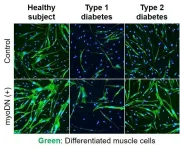(Press-News.org) Modern genetic research often works with what are known as reference genomes. Such a genome comprises data from DNA sequences that scientists have assembled as a representative example of the genetic makeup of a species.
To create the reference genome, researchers generally use DNA sequences from a single or a few individuals, which can poorly represent the complete genomic diversity of individuals or sub-populations. The result is that a reference does not always correspond exactly to the set of genes of a specific individual.
Until a few years ago, it was very laborious, expensive and time-consuming to generate such reference genomes. For this reason, researchers concentrated on human genomes and the most important biological model organisms, such as the roundworm C. elegans.
However, as researchers now have access to fast sequencing machines, sophisticated algorithms that assemble DNA sequence readouts into complete chromosomes, and much greater computing power, creating reference genomes for other species has become increasingly practical. If researchers are to better understand evolution and other fundamental questions of biology, they need high-quality reference genomes for as many species as possible.
This includes livestock. For domestic cattle (Bos taurus), only a single reference genome was available until recently: from a Hereford cow called Dominette. Researchers had previously compared other DNA sequences of cattle against this reference to detect genetic variations and define corresponding genotypes. However, as it did not contain any genetic variants by which individuals differ, the previous reference did not reflect the diversity of the species.
Gap filled
A research team led by Hubert Pausch, Assistant Professor of Animal Genomics at ETH Zurich, has now filled this gap: with the genomes of three further breeds of domestic cattle, including the Brown Swiss (Original Schweizer Braunvieh), two closely related (sub-)species such as the zebu and the yak, and the existing reference genome for domestic cattle, the researchers have created a "pangenome". The study detailing these findings has just been published in the scientific journal PNAS.
This cattle pangenome integrates sequences contained in the six individual reference genomes. "This means we can reveal very precisely which sequences are missing, for example, in the Hereford based reference genome, but are present in, say, our Brown Swiss genome or the genomes of other cattle breeds and species," Pausch says.
New genes and functionalities discovered
In this way, the ETH researchers discovered numerous DNA sequences and even whole genes that were missing in the previous reference genome of the Hereford cow. In a further step, the researchers investigated the transcripts of these genes (messenger RNA molecules), which allowed them to classify some of the newly discovered sequences as functionally and biologically relevant. Many of the genes they discovered are connected with immune functions: in animals that had contact with pathogenic bacteria, these genes were stronger or less active than in animals that had no contact with the pathogens.
This project was made possible by a new sequencing technology that has been available at the Functional Genomics Center Zurich for a year now. With this new technology, the researchers are able to precisely read out long DNA sections, reducing the complexity of the computing process needed to correctly assemble the analysed sections. "The new technology simplifies the genome assembly process. Now we can create reference genomes quickly and precisely from scratch," Pausch says. In addition, such analyses also cost less, meaning that researchers can now generate genomes in reference quality from many individuals of a species.
The ETH researchers are collaborating closely with the Bovine Pangenome Consortium, which wants to create a reference genome of at least one animal from every cattle breed worldwide. It also plans to analyse the genetic makeup of wild relatives of domestic cattle in this way.
More targeted breeding possible
The consortium and ETH professor Pausch hope that the reference genome collection will help them make useful discoveries such as genetic variants that are no longer present in domesticated animals, but that their wild relatives still possess. This would provide clues as to which genetic characteristics were lost as a result of domestication.
"Things get really exciting when we compare our indigenous cattle with the zebu or with breeds that are adapted to other climate conditions," Pausch explains. This lets researchers find out which genetic variants make animals in tropical environments more heat tolerant. The next step could be to deliberately use crossbreeding to introduce these variants into other cattle breeds or precisely introduce them through genome editing. However, that is still a long way off. For the present, researchers can benefit from the greater speed and precision that the new cattle pangenome brings to the process of detecting the genes and DNA variants that differ between cattle breeds.
INFORMATION:
Many eye diseases are associated with a restricted blood supply, known as ischaemia, which can lead to blindness. The role of the protein tenascin-C, an extracellular matrix component, in retinal ischaemia was investigated in mice by researchers from Ruhr-Universität Bochum (RUB). They showed that tenascin-C plays a crucial role in damaging the cells responsible for vision following ischaemia. The results were published online by the team in the journal Frontiers in Neuroscience on 20 May 2021.
As part of the research, the team around Dr. Susanne Wiemann and Dr. Jacqueline Reinhard from the Department of Cell Morphology and Molecular Neurobiology at RUB collaborated with Professor Stephanie Joachim's research group from ...
Included in the vast fallout stemming from the COVID-19 pandemic, scientists are paying closer attention to microbial infections and how life forms defend against attacks from pathogens.
Research led by University of California San Diego scientists has shed new light on the complex dynamics involved in how organisms sense that an infection is taking place.
UC San Diego Assistant Project Scientist Eillen Tecle in Professor Emily Troemel's laboratory (Division of Biological Sciences) led research focusing on how cells that are not part of the conventional immune system respond to infections when pathogens attack. Scientists have conducted extensive research on so-called "professional" immune cells that are defensive specialists. Much less is known about how "non-professional" cells ...
Alzheimer's disease - also called dementia - where memory and cognitive functions gradually decline due to deformation and death of neurons, and Parkinson's disease that causes tremors in hands and arms impeding normal movement are major neurodegenerative diseases. Recently, a research team at POSTECH has identified the structure of the agent that causes Alzheimer's and Parkinson's diseases to occur together.
A research team led by Professor Joon Won Park and Ph.D. candidate Eun Ji Shin of the Department of Chemistry at POSTECH investigated the surface structure of hetero-oligomers found in the overlap of Alzheimer's disease and Parkinson's disease, using an atomic force microscopy (AFM) to reveal their structural identity. This study was featured as the ...
While the plates carry water to the Earth's interior, phase transitions of dry olivine, the main mineral in the plates, are thought to be responsible for deep-focus earthquakes and plate deformation. This study resolves the contradiction of the presence of dry olivine even in wet plates. Takayuki Ishii, a researcher at the Center for High Pressure Science & Technology Advanced Research (HPSTAR), China and the Bavarian Institute of Geosciences, University of Bayreuth, Germany, and Eiji Otani, a professor emeritus at Tohoku University, used high-pressure and high-temperature experiments to determine the water content of olivine under ...
Tiny charged electrons and protons which can damage satellites and alter the ozone have revealed some of their mysteries to University of Otago scientists.
In a study, published in Geophysical Research Letters, the group looked at charged particles interacting with a type of radio wave called 'EMIC' - a wave generated in Earth's radiation belts (invisible rings of charged particles orbiting the Earth).
Lead author Dr Aaron Hendry, of the Department of Physics, says it is important to understand how these waves affect the belts - which are filled with expensive and important satellites - and Earth's climate.
"Much like the Earth's atmosphere, the Earth's magnetosphere - the region around the Earth where our magnetic field is stronger ...
A new study from the University of Kent, Toulouse Business School, ESSCA School of Management (Paris) and ESADE Business School (Spain) has revealed the three primary risks and benefits perceived by consumers towards autonomous vehicles (self-driving cars).
The increased development of autonomous vehicles worldwide inspired the researchers to uncover how consumers feel towards the growing market, particularly in areas that dissuade them from purchasing, to understand the challenges of marketing the product. The following perceptions, gained through qualitative interviews and ...
There is growing evidence that house design can decrease the force of malaria infection.
The world's most deadly assassin is Africa's malaria mosquito: Anopheles gambiae. In 2019, the World Health Organisation estimated that malaria killed 386,000 people in sub-Saharan Africa, mainly children.
Whilst we think of the home as a sanctuary, in Africa, around 80% of the malaria bites occur indoors at night. Preventing mosquitoes from getting indoors is a simple way of protecting people from this often lethal disease.
As most mosquitoes fly low to the ground, a team of researchers led by Durham University wondered whether ...
Fishery and aquaculture have given rise to an enormous uniformity in the diversity of bivalves along the more than 18,000 kilometer long Chinese coast, biologist He-Bo Peng and colleagues report in this month's issue of Diversity and Distributions.
Climate zones
Peng and colleagues sampled bivalves at 21 sites along the Chinese coast from the city of Dongliaodao in the tropical south, to the mudflats of Yalu Jiang, more than 2000 km further north and ice-covered for several months in winter. "At 19 out of these 21 sites, commercially exploited species dominated", Peng saw. "In the naturally occurring species, we still recognized the natural gradient with highest diversity in the tropics and lowest diversity in ...
The Manchester Arena terrorist bomb attack in 2017 exposed flaws in the response of emergency services that could be addressed with a new three-phase approach, research by the University of Bath School of Management shows.
Current government guidelines outline a two-phase structure of 'response and recovery', which researchers discovered hampered effective communication between agencies, created over-reliance on centralised Police decision-making, and inhibited other services' ability to take initiative earlier in an emergency.
"To better prepare responders for emergencies we recommend a three?phase structure of 'response/resolve/recovery' is introduced in place of the current guidelines ...
Skeletal muscle is the largest organ in the body that accounts for 30 to 40% of body weight and is responsible for multiple functions such as energy metabolism and heat production. However, skeletal muscle mass is reduced in some diabetics, and that muscle loss correlates with mortality. It has been reported that the differentiation of myoblasts, which are the muscle precursor cells, is reduced in diabetic patients, and this is thought to be one of the underlying causes of muscle loss.
Assistant Professor Tomohide Takaya of Shinshu University recently reported that oligo DNA derived from the genome ...





